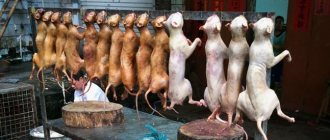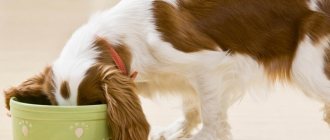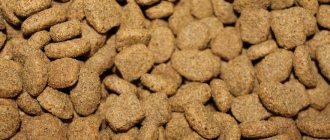Any dog is initially a healthy animal that can maintain its vigor and excellent physical shape throughout its life only if it has excellent living conditions, which, in addition to its habitat, upbringing and grooming procedures, include a daily routine and nutritional schedule, which must be verified and secured once and for all.
The animal needs a clear daily routine, to which it gets used to from childhood. In this case, the body will work like a clock, without any failures. If you constantly violate the established order, including feeding the dog different times at different times, then the animal’s health will quickly deteriorate.
How to feed a dog at home: basic rules
Any dog - purebred or an ordinary street mongrel - needs adequate nutrition. The body of these animals is different from the body of people, so feeding your pet everything that people eat is unacceptable. There are a number of foods that are familiar to humans, but which can cause serious problems with the functioning of the digestive organs in dogs.
Basic rules for feeding dogs:
1. Do not give food from the table. Humans eat food with various spices and other ingredients that can be especially harmful to dogs. 2. You cannot overfeed the animal. The daily ration rate is calculated taking into account the dog’s age and breed. 3. The number of feedings is 3-4 times a day for puppies and 2 times a day for adult dogs. During pregnancy, lactation and illness, the dog can be fed 3-4 times a day. 4. An animal’s daily diet must contain microelements that are beneficial for its body. 50% of the diet consists of meat and protein foods, approximately 20-30% is allocated to cereals, about 20% to dairy products and no more than 10% to vegetables and fruits. 5. It is better to feed the dog at the same time according to the schedule, for example, 1.5-2 hours before a walk or an hour after a walk. 6. Experts do not recommend feeding your dog during the day. Additional complementary feeding is only relevant during physical training. 7. After feeding your dog, you should not allow uneaten food to remain in the bowl. The container should be cleared of food residues and washed. 8. If there are several dogs living in the house, each of them should be provided with a separate bowl for food and water. 9. Pets should always have clean drinking water freely available.
Choosing food for your dog
When a dog appears in the house, it is advisable to immediately decide on the optimal type of food - natural food or ready-made industrial food.
Do not rush to make a rash choice; this issue should be approached with all responsibility, taking into account the breed of the dog and your own convenience. For example, for people who work from morning to late evening, the optimal choice is feeding with ready-made food, eliminating the need to prepare special food for the dog.
You should also keep in mind that high-quality dog food is not cheap. But you will also have to spend money on purchasing good food products necessary for a complete daily diet.
Feeding dogs with ready-made food
Ready-made industrial food is a convenient product for feeding pets that does not require preparation and calculations of the constituent components, as required by natural feeding.
There are two types of ready-made dog food - dry in granules and wet in cans with various flavoring additives. If dry food is chosen for feeding your pet, it is very important that the animal always has access to the water necessary for the absorption of granulated food.
The range of pet products includes a large selection of dog food from different manufacturers. All of them are divided into several categories: economy, premium, super-premium. Experts do not recommend buying cheap food for animals that has a low-quality or unbalanced composition, as well as all kinds of additives and flavor enhancers that are unsafe for the animal’s body. Such savings will lead to even greater costs for the treatment of a four-legged friend.
Puppy
Depending on age, the number of meals will vary from 6 times every 2 months, to an adult schedule with breakfast and dinner by 10-12 months, depending on the breed. When drawing up a schedule, it is necessary to take into account not only age and times, but also the time intervals between meals. By reducing feedings and increasing portion sizes, you try to maintain the same time intervals.
Puppies need to be fed:
| Age in months | Number of feedings per day | Approximate time |
| 1-2 | 6 | IN 7, 10, 13, 16, 19, 22 |
| 2-3 | 5 | IN 7, 10, 14, 18, 22 |
| 3-4 | 4 | IN 7, 12, 17, 22 |
| 4-6 | 3-4 | IN 7, 12, 17, 22 |
| 6-10 | 3 | IN 7, 13 21 |
| from 10 | 2 | IN 7, 21 |
Recommendations for choosing dog food:
1. Consider the age and size of the dog.
All foods have labels indicating what type of animal the particular product is intended for. For example, there are special foods for puppies, for pregnant and lactating dogs, for animals after sterilization, castration, etc. 2. Carefully study the composition of the food. Perhaps some ingredients are contraindicated specifically for your animal. 3. Pay attention to the date of manufacture, expiration date and storage rules for the food. It is unacceptable to give your pet an expired product. Experienced breeders and veterinarians recommend choosing premium, super-premium or holistic food for pet dogs that has a balanced composition that is beneficial for the animal’s body.
Eating natural products
For many owners, the optimal solution is to choose natural products to feed their dog. When determining this type of nutrition, you need to immediately calculate the required daily portion for the animal, taking into account its age and breed. It is important to remember that the products served must contain all the necessary vitamins, minerals and other beneficial microelements in the correct ratio. If you have difficulty calculating your diet, consult an experienced veterinarian.
Pros of natural feeding:
1. The owner can independently choose quality products for the dog.
2. It becomes possible to completely eliminate unsafe additives, dyes, chemical elements and preservatives from the dog’s diet, which will undoubtedly benefit its body and eliminate the risks of developing various diseases. 3. If a dog is allergic to a specific food product, it can be quickly removed from the menu and replaced with an alternative product that does not cause such reactions. 4. High-quality nutrition with natural products will ensure healthy functioning of the digestive tract. Natural food for dogs involves preparing individual meals for your pet from high-quality and fresh food. It is unacceptable to cook a week ahead. Food must be fresh. Food is served to the animal exclusively warm (not hot, but not cold either).
Mixed feeding
Some owners choose to feed their dogs a mixed diet, which involves a combination of dry food with natural products.
Important:
1. It is unacceptable to give your dog natural food and food at the same time.
2. Between feeding different types of food there should be intervals of several hours. This is due to the following: it takes 3-5 hours to digest food granules, and no more than 2.5 hours to digest regular foods. In addition, different enzymes are needed to digest different types of food, and it will be difficult for the body to absorb both at the same time. With mixed feeding, it is difficult to calculate the ratio of various microelements in food and natural food, so before choosing this type of diet, think about whether you are ready for such complex calculations, because the health and lifespan of your pet will depend on the balance of nutrition.
Useful tips
If your dog flatly refuses to eat fresh vegetables, then you can use a little trick. Lightly boiled or stewed vegetables may be to the taste of a picky four-legged pet.
Dog handlers advise excluding sweet, smoked, spicy, and salty foods from your pet’s diet. And under no circumstances should you mix natural menus and ready-made diets.
If absolutely necessary, the transition should be gradual so that the dog’s body can adapt. The duration of adaptation cannot be less than 14 days.
BARF dog feeding system
In recent years, the BARF animal feeding system has become increasingly popular among dog breeders. This type of nutrition is based on natural food, close to wild nature.
The basis of the BARF diet:
• meat bones;
• raw meat of different varieties; • offal; • fish, including raw fish; • raw vegetables in any quantity; • greenery; • raw eggs; • dairy products; • fruits and berries; • olive and linseed oil; • fish oil or cod liver oil. According to the founder of the BARF animal feeding system, dogs are predators, so the basis of their diet should be the natural diet of their wild ancestors. Such food is useful and healthy for animals. As for raw foods, according to the author of this feeding method, food after heat treatment loses a number of nutrients necessary for the body, and therefore is useless for the animal.
You need to gradually accustom your dog to eating according to the BARF system, following some recommendations from the creator of the method. In order for the body to get used to such food, at first, 30 minutes before meals, you need to give the dog a prebiotic and bifidobacteria, which normalize the intestinal microflora. Each new product is introduced gradually, in small quantities. As soon as the dog completely switches to the new diet, you can eliminate the medicinal components, since they will no longer be needed by a healthy body.
Vitamins
Supplements for dogs are usually available in tablet form. They have an attractive aroma and taste. For particularly picky individuals, multivitamin complexes in powder or drops are suitable.
This is interesting: 10 tips on how to accustom a puppy to dry food
They are mixed into food or water, and also applied to the animal’s tongue. The drug is selected on the recommendation of a veterinarian, taking into account the breed and its weight.
Calcium, phosphorus and phytin are needed by puppies and adults for the formation and maintenance of bone tissue. But constantly adding vitamins to your diet is not recommended. They should be given in courses with a break of 2 weeks to 3 months.
For dogs receiving natural feeding, dog handlers and veterinarians advise choosing natural mineral supplements.
But ready-made pharmacological preparations (yeast SFK, Canina, Welpenkalk) can provoke a histamine reaction or indigestion in the animal.
RAW power system
Another popular method of feeding domestic dogs is RAW, which is also based on natural raw food. Unlike the BARF system, this method involves feeding the animal meat not in a cut state, but in the form of a carcass or half-carcass. The meat should have bone and blood. There is a taboo on foods that have undergone heat treatment, as well as on chopped bones.
The RAW diet includes offal and sea fish, preferably whole and fresh. But dairy products, eggs, vegetables and fruits are completely excluded from the daily menu of a dog eating according to the RAW system.
By the way, RAW and BARF nutrition is inappropriate for feeding dogs of decorative breeds, since their body is not adapted to assimilate food familiar to predators in the wild.
Diet during pregnancy
The diet for dogs carrying puppies should be rich in nutrients. Give preference to high-quality feed, and also give a complex of vitamins.
You should not radically change food during pregnancy. Increase the portion weekly from the second trimester by no more than 10%.
The saturation of nutrients must be sufficient to meet the needs of not only the mother’s body, but also the fetus. Pay special attention to proteins, fats, and minerals. You should not overfeed the animal, as obesity interferes with normal childbirth.
What you can and cannot feed your dog: list of products
Since most dog breeders choose a natural type of diet for feeding, let’s consider what foods should be included in a pet’s daily menu and what should not be given to animals, even sometimes.
Healthy foods for dogs:
• meat, poultry;
• offal; • chicken and quail eggs; • cereal porridge (rice, buckwheat, oatmeal, barley); • fresh vegetables; • greenery; • unsweetened berries and fruits as a tasty treat; • fermented milk products with a small percentage of fat content; • pumpkin, olive, flax oil; • bran; • raw bones (except tubular ones); • sea fish (no more than 1-2 times a week). What you should not feed dogs: • bakery products; • sweet pastries; • pasta; • it is undesirable to feed fatty meat; • pickles and preserves are prohibited; • mushrooms; • fried foods; • corn and semolina (poorly digestible); • soy products; • grapes; • garlic, onions; • spices should not be given. To keep your dog healthy, physically strong, and live for many years in your home, create for it a healthy and balanced diet of high-quality, fresh food. If you choose ready-made industrial feeds for feeding, give preference to products of proper quality. Remember: your pet's health is in your hands!











